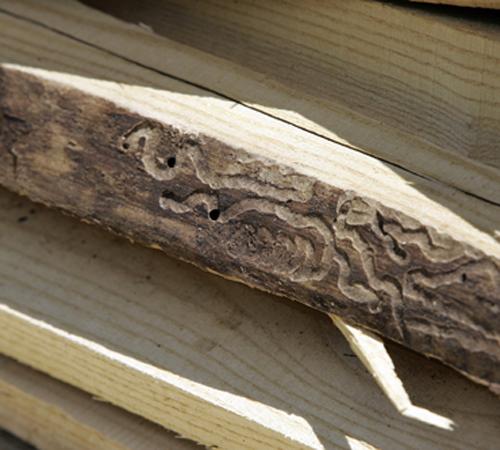Beetle-bitten timber rises from ashes

A closeup of wood from an ash tree that was infested by the emerald ash borer is shown in Farmington Hills, Mich., on Friday. The ash tree was cut by Lee Ullmann of Ullmann Urban Sawmill. Carlos Osorio, The Associated Press
Jul 25, 2007
Last updated on May 12, 2016 at 01:58 p.m.
TOLEDO, Ohio – Ash trees are being turned into baseball bats for Little Leaguers, park benches and baby furniture, as cities around the Midwest try to get rid of millions of trees killed by a paperclip-size beetle.
The emerald ash borer has killed or prompted state officials to cut down about 25 million trees in Illinois, Indiana, Maryland, Michigan, Ohio and Pennsylvania since it first was discovered in the United States five years ago. And it’s on the move, with federal agriculture officials predicting it could spread to the east-central United States within the next two decades.
“We wanted to get value out of them before we lost them,” said Steve Gruner, director of the Sandusky County Park District in Ohio where ash trees were used to renovate a historic barn.
Workers in Monroe, Mich., built park benches, picnic tables and sign posts. Ash floors and paneling are being installed in a library in Ann Arbor, Mich.
Get The Daily Illini in your inbox!
And in Glenview, Ill., they’re being turned into baseball bats for Little Leaguers.
“Almost every tree is usable in some form,” said Bruce Horigan, who owns Horigan Urban Forest Products in the Chicago suburb. “These trees are coming down anyway.”
Because the beetle bores only a half-inch under the bark, nearly all the wood is usable. But the trees will die within a few years and those that pose a hazard must be cut down.
Only a few cities, however, are preparing for disposal of the dead trees, and most trees still end up as firewood or mulch.
The U.S. Department of Agriculture estimates that states and cities could spend $7 billion over the next 25 years cleaning up and replacing ash trees.
In Michigan, where the ash borer first hit, most cities had little time to react because the pest went undetected for so long.
Most of the trees were ground into mulch for homeowners and chips for a wood-burning power plant in Flint – 300,000 tons of wood were sent to the plant in about one year, said Jessica Simons, of the Southeast Michigan Resource Conservation and Development Council.
The organization, funded by the U.S. Forest Service, wants cities to do more with the trees and will help connect municipal leaders with sawmill owners and other businesses that need wood.
“We generate a lot of wood in urban areas and we generally treat it as waste,” Simons said.
There are limits on ash, though. In most areas where the pest has spread, ash wood can’t be moved out of the area unless it is kiln-dried or fumigated.
Ash is a dense wood used to make furniture, flooring, railroad ties and baseball bats.
Brian Colter, the city forester in Grosse Pointe Park, Mich., has a collection of ash-made items in his office, including coasters and a coffee mug. A bench inside City Hall came from the first tree the city cut down in 2002.
“It’s mostly for nostalgic reasons,” Colter said. “Our utilization of ash wood is nominal compared with the number of ash trees we’re taking down.”
Kathy Hawley-Herzog is turning her 80-foot tall ash tree that shaded a backyard patio in the Detroit suburb into a banister and chair rail for her family’s cottage in northern Michigan. Her husband, a woodworker, plans to make baseball bats, too.
“We’ve got enough to keep him busy the rest of his life,” she said.





